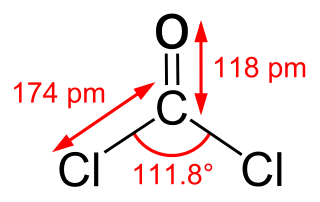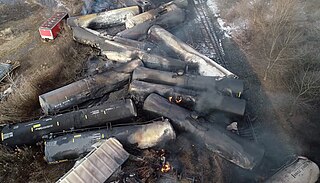
Phosgene is an organic chemical compound with the formula COCl2. It is a toxic, colorless gas; in low concentrations, its musty odor resembles that of freshly cut hay or grass. It can be thought of chemically as the double acyl chloride analog of carbonic acid, or structurally as formaldehyde with the hydrogen atoms replaced by chlorine atoms. Phosgene is a valued and important industrial building block, especially for the production of precursors of polyurethanes and polycarbonate plastics.

Paulsboro is a borough situated on the banks of the Delaware River within Gloucester County, in the U.S. state of New Jersey, within the Philadelphia metropolitan area. As of the 2020 United States census, the borough's population was 6,196, an increase of 99 (+1.6%) from the 6,097 recorded at the 2010 census, which in turn had reflected a decline of 63 (−1.0%) from the 6,160 counted in the 2000 census. Paulsboro and surrounding Gloucester County constitute part of South Jersey.

East Palestine is a village in northeastern Columbiana County, Ohio, United States. The population was 4,761 at the 2020 census. Located on the state's border with Pennsylvania, East Palestine is about 20 miles (32 km) south of Youngstown and 40 miles (64 km) northwest of Pittsburgh.

CSX Transportation, known colloquially as simply CSX, is a Class I freight railroad company operating in the Eastern United States and the Canadian provinces of Ontario and Quebec. Operating about 21,000 route miles (34,000 km) of track, it is the leading subsidiary of CSX Corporation, a Fortune 500 company headquartered in Jacksonville, Florida.

Vinyl chloride is an organochloride with the formula H2C=CHCl. It is also called vinyl chloride monomer (VCM) or chloroethene. This colorless compound is an important industrial chemical chiefly used to produce the polymer, poly(vinyl chloride) (PVC). Vinyl chloride monomer is among the top twenty largest petrochemicals (petroleum-derived chemicals) in world production. The United States remains the largest vinyl chloride manufacturing region because of its low-production-cost position in chlorine and ethylene raw materials. China is also a large manufacturer and one of the largest consumers of vinyl chloride. Vinyl chloride is a flammable gas that has a sweet odor and is carcinogenic. It can be formed in the environment when soil organisms break down chlorinated solvents. Vinyl chloride that is released by industries or formed by the breakdown of other chlorinated chemicals can enter the air and drinking water supplies. Vinyl chloride is a common contaminant found near landfills. Before the 1970s, vinyl chloride was used as an aerosol propellant and refrigerant.

The Norfolk Southern Railway is a Class I freight railroad operating in the Eastern United States. Headquartered in Atlanta, the company was formed in 1982 with the merger of the Norfolk and Western Railway and Southern Railway. The company operates 19,420 route miles (31,250 km) in 22 eastern states, the District of Columbia, and has rights in Canada over the Albany to Montreal route of the Canadian Pacific Kansas City. Norfolk Southern Railway is the leading subsidiary of the Norfolk Southern Corporation.

The Graniteville train crash was an American rail disaster that occurred on January 6, 2005, in Graniteville, South Carolina. At roughly 2:40 am EST, two Norfolk Southern trains collided near the Avondale Mills plant in Graniteville. Nine people were killed and over 250 people were treated for toxic chlorine exposure. The crash was determined to be caused by a misaligned railroad switch.

The Weyauwega derailment was a railroad accident that occurred in Weyauwega, Wisconsin, United States, in the early morning hours of March 4, 1996. The derailed train was carrying a large quantity of hazardous material, which immediately caught fire. The fire, which involved the train cars and an adjacent feed mill, burned for more than two weeks after the actual derailment, resulting in the emergency evacuation of 2,300 people for 18 days, including the entire city of Weyauwega, with about 1,700 evacuees.
The Chemical Coast is a section of Union and Middlesex counties in New Jersey located along the shores of the Arthur Kill, across from Staten Island, New York. The name is taken from the Conrail Chemical Coast Line, an important component in the ExpressRail system serving marine terminals in the Port of New York and New Jersey.
Mantua Creek is a tributary of the Delaware River in Mantua Township, Gloucester County, New Jersey. Mantua Creek's headwaters are near Glassboro, flowing northwest for 18.6 miles to the Delaware River at the Port of Paulsboro in Paulsboro across from present-day Philadelphia International Airport.
The Port of Paulsboro is located on the Delaware River and Mantua Creek in and around Paulsboro, in Gloucester County, New Jersey, approximately 78 miles (126 km) from the Atlantic Ocean. Traditionally one of the nation's busiest for marine transfer operations, notably for crude oil and petroleum products, such as jet fuel and asphalt, it is a port of entry with several facilities within a foreign trade zone.

In rail transport, the U.S. DOT-111 tank car, also known as the TC-111 in Canada, is a type of unpressurized general service tank car in common use in North America. Tank cars built to this specification must be circular in cross section, with elliptical, formed heads set convex outward. They have a minimum plate thickness of 7⁄16 inch (11.1 mm) and a maximum capacity of 34,500 US gallons. Tanks may be constructed from carbon steel, aluminum alloy, high alloy steel, or nickel plate steel by fusion welding.

Penns Grove Secondary is a rail freight line in the Delaware Valley in the southwestern part of New Jersey. Part of Conrail's South Jersey/Philadelphia Shared Assets it runs for approximately 20 miles (32 km) between its southern terminus at Penns Grove and Woodbury at the north where it joins the Vineland Secondary about 8.5 miles (13.7 km) south of Pavonia Yard in Camden. At its southern end the Deepwater Point Running Track continues another 3.7 miles (6 km) through Carneys Point to Deepwater.
The 2015 Tennessee train derailment occurred on July 2, 2015. A CSX Transportation train derailed at Maryville, Tennessee. The train was carrying toxic chemicals, leading to an evacuation of over 5,000 people.

South Jersey Port Corporation (SJPC) is an independent public port authority which operates the ports along the eastern banks of Delaware River in the Delaware Valley region of southern New Jersey in the United States. Based in Camden, SJPC was founded in 1928 and changed its name in 1968. It maintains facilities at the Port of Camden, the Port of Paulsboro, and the Port of Salem.

A train derailment occurred on February 3, 2023, at 8:55 p.m. EST (UTC−5), when 38 cars of a Norfolk Southern freight train carrying hazardous materials derailed in East Palestine, Ohio, United States. Several railcars burned for more than two days, with emergency crews then conducting a controlled burn of several railcars, which released hydrogen chloride and phosgene into the air. As a result, residents within a 1-mile (1.6-kilometer) radius were evacuated, and an emergency response was initiated from agencies in Ohio, Pennsylvania, West Virginia, and Virginia.
At 4:25 pm on July 8, 1986, a 44 car Baltimore and Ohio railroad freight train, traveling at 45 miles per hour, bound south to Cincinnati, derailed near Miamisburg, Ohio, a small city with an industrial history in Montgomery County, southwest of Dayton. Fifteen of the cars derailed on a bridge; these were tank cars containing yellow phosphorus, molten sulfur and tallow. Carrying a chemical used to make rat poison, fireworks and luminescent coatings, one tank car caught fire. This resulted in emission of an estimated 1,000 foot (300 m) high cloud of phosphorus. A subsequent incident caused the largest train accident-triggered evacuation at the time in the United States. The accident was the second major rail disaster in Miamisburg within an eight-year period. On September 10, 1978, 15 cars of a Conrail train derailed.
On June 30, 1992, a Burlington Northern Railroad freight train derailed on a bridge over the Nemadji River at the southern edge of town of Superior, Wisconsin. The derailment resulted in a liquid benzene spill into the river. The fumes from the spill led to an evacuation of an estimated 80,000 residents from the town of Superior, the city of Superior and Duluth, Minnesota, apparently the largest evacuation in U.S. history resulting from a train accident.














